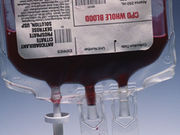Longer-storage RBC units non-inferior for children with lactic acidosis due to anemia
MONDAY, Dec. 7, 2015 (HealthDay News) — For children with lactic acidosis due to severe anemia, transfusion with longer-storage red blood cell (RBC) units is noninferior to shorter-storage RBC units, according to a study published online Dec. 5 in the Journal of the American Medical Association. The research was published to coincide with the annual meeting of the American Society of Hematology, held from Dec. 5 to 8 in Orlando, Fla.
Aggrey Dhabangi, M.D., from Makerere University in Kampala, Uganda, and colleagues conducted a randomized noninferiority trial in 290 children, most with malaria or sickle cell disease, who presented with a hemoglobin level of 5 g/dL or lower and a lactate level of 5 mmol/L or higher. Patients were randomized to receive RBC units stored for 25 to 35 days (median: 32 days; 145 patients) versus one to 10 days (median: eight days; 145 patients).
The researchers found that the proportion achieving the primary end point of a lactate level of 3 mmol/L or lower at eight hours was 0.61 in the longer-storage group versus 0.58 in the shorter-storage group (between-group difference, 0.03; P < 0.001), which met the prespecified criteria for noninferiority. At zero, two, four, six, eight, or 24 hours there was no significant between-group difference in the mean lactate levels.
“These findings have relevance regarding the efficacy of stored RBC transfusion for patients with critical tissue hypoxia and lactic acidosis due to anemia,” the authors write.
One author disclosed financial ties to the Haemonetics Corporation; Nonin Corporation supplied the equipment used for noninvasive cerebral oxygen measurements.
Copyright © 2015 HealthDay. All rights reserved.








